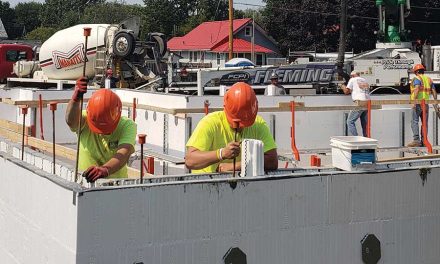Roughly estimating, well over 30 million square feet of ICF walls are filled with concrete annually.
Voids are rare, and with proper procedures and training, can be eliminated altogether. This is a big concern that contractors, inspectors, and future clients hear, and they think, is the possibility of having voids in the concrete, compromising the structural integrity of the wall?
Several Factors Create Voids
Let’s start this article by stating that ICF is designed to prevent voids in the concrete. Voids are created during concrete placement, as a result of several factors by the installing contractor. A void is basically an air pocket or empty space in the concrete that may influence the structural integrity of the wall. The hole could be small, anywhere from the size of a fist to the size of a melon or larger. In theory, voids are not supposed to happen when placing the concrete, but procedures by the installing crew may create these negative reactions which occur in the wall assembly. Let’s analyze how and why a void or air pocket could happen or should not happen.
How To Create Voids
First, look at a number of ways on how to create a void in your ICF wall assembly:
- Do not follow manufacturer instructions on ICF concrete mix design, aggregate size, or slump.
- Delay in placing concrete, allowing concrete to set-up or stiffen during placement.
- Abundance of rebar, from the design of the wall, restricting the passage of the concrete and aggregate.
- Incorrect placement of horizontal rebar being too close together or too close to the block face.
- No, bad, or spotty consolidation, not moving all the air up and out of the concrete.
- Not consolidating around openings, sleeves, and embedments.
- Failure to control the continuous flow of concrete during placement or between lifts
- Inadequate vibrating/consolidation equipment.
- Lack of attention during placement and consolidation.
Generally, all these factors may contribute to creating voids. Installers must be aware during the build, rebar, and concrete placement of the steps they should take to eliminate the possibility of creating any type of restriction for concrete during placement. Following correct procedures and using appropriate equipment during consolidation goes a long way. Consolidation is the key to eliminating air pockets and voids. Disregard any advice that says that consolidation is not required. This is not the stage of the build to try and reinvent the wheel, cut corners to save time, or cut corners to save money. Using a higher slump concrete to alleviate consolidation creates more installation issues which requires more experience. I recommend that you not go that route without a solid knowledge base.
Mix Design
The ICF concrete mix design has been developed with a higher slump (5-6 inches) and a smaller aggregate. This is to allow for a better flow during placement and the ability to encase the rebar. The concrete deliveries must be planned and organized, allowing the correct timing for each truck’s arrival and placement in the walls, without the concrete starting to set-up. Adding plasticizers improves the flow but also accelerates the curing and stiffens the concrete, which if not placed in a timely manner, creates problems. Installers need to communicate with the ready-mix supplier to get the correct slump and mix design for an ICF project. Develop a delivery timing plan that allows for efficient offloading of the ready-mix trucks into the pump truck. Have your crew and equipment ready to place concrete into the walls. Concrete placement rates are influenced by temperature, and the pumper will adjust the flow rate per these site conditions.
Double Mat Rebar
Some ICF designs may require double mat rebar, which, when installed with non-contact lap joints, could create a tight area for concrete to pass. This is one reason why a smaller aggregate is required in the concrete mix. These areas must be watched during placement to ensure there is no concrete build-up, blocking the flow and creating a void under these spots. Also, lintels and areas around opening will have more rebar, requiring more attention and more consolidation to eliminate the
air pockets.
Watch The Flow
During placement, the installer must carefully and constantly watch the concrete flow inside the wall. This provides the opportunity to see any restriction happening, stop placement, and quickly clear the problem. The crew member that is operating the vibrator should be following closely behind the concrete placement. The crew member doing the consolidation must understand the concept and be trained on the operation of the equipment. Problems may occur with either not enough consolidation or over consolidation, creating too much pressure on the wall assembly and possibly creating a blow-out.
Consolidation
Consolidation is the most important function in eliminating the air in the concrete. Internal consolidation with an internal vibrator wand, consolidating all areas from bottom to top, is the best method. The vibrator should be directly following the concrete placement to ensure the concrete has not started to stiffen. External vibrators must work the wall from the bottom to top, moving the air up and out of the concrete. The vibrator needs to be applied to specific areas that may be prone to air pockets — under sills, corners of openings, around sleeves or embedments. Whatever vibrating or consolidation methods are employed, they must work to move air up and out of the concrete, for the full wall height. Failure to consolidate and remove the air may result in voids and/or honeycombing within the wall assembly.
If voids in the wall are suspected, tapping on the blocks and listening for the difference between a solid wall and hollow wall could identify an area of a void. Use a wire probe to stick through the EPS to either hit concrete or hit a void.
Voids, depending on size, location may not be a structural issue. If the rebar is not encased in concrete, then it may be more serious. Once a void is found, the whole wall may be suspect and may have to be examined. Walls may be examined with a thermal camera or x-ray equipment.
To Fix A Void
To fix a void, remove the insulation around the problem area and fill the void with a high-strength concrete grout, then replace the insulation.
ICF engineering states that an ICF wall can have an opening 24×24 inches without additional rebar support. This means a small void is not necessarily a structural issue and the repair may make the wall whole or structurally sound again. Honeycombing is smaller air pockets, and depending on severity of the issue, they are basically not a consideration of the structural integrity or wall efficiency.
ICFs are an ideal formwork for concrete and, due to the double layers of insulation, enhance the overall strength of concrete during the curing process. Following ICF manufacturers’ instructions for concrete mix design, placement, and consolidation procedures will lead to a solid wall assembly. The concrete placement and consolidation phase of every project is the time for full attention by the installation crew to ensure correct procedures are followed to prevent these problems from occurring.

Tom Patton
Tom Patton had a 30-year architectural design background prior to joining the ICF industry in 2001 with the technical support department at ARXX. Over the last 20 years, Tom has worked with major ICF companies developing technical documentation, application details, and training programs, as well as consulting and promoting ICFs with various associations including the ICFMA, NRMCA, and codes and standards committees. Currently, Tom is Corporate Brand Ambassador for Fox Blocks and co-developer of the Fox Blocks Integrated Learning Center.









Given self consolidating concrete has high slump of 18-30 inches, and when combined with appropriately engineered micro rebar (such as Helix) replacing some of the rebar, consolidating becomes much easier. Its really too bad the author hasn’t taken the time to learn about these technologies which have been around for quite some time. Vibrating is a chance operation compared to SCC